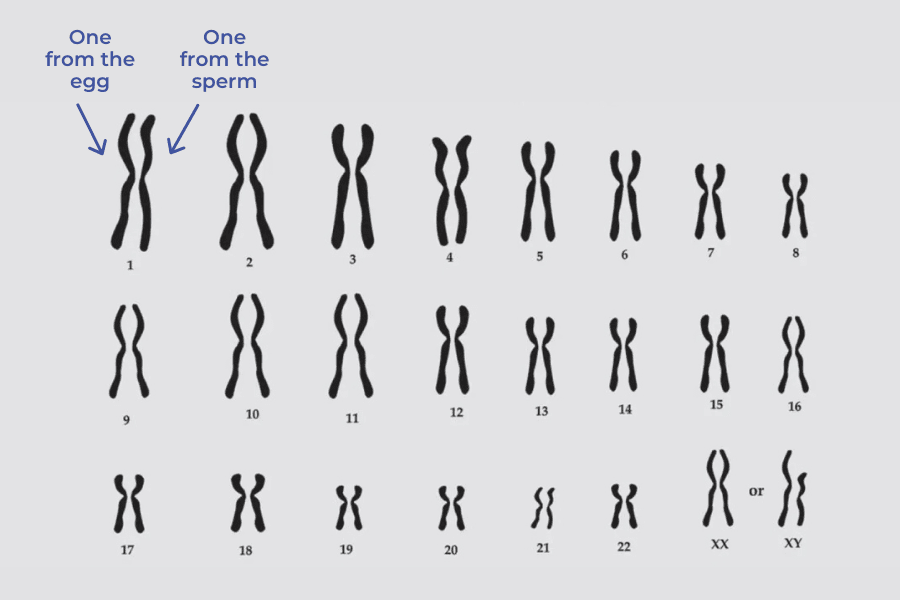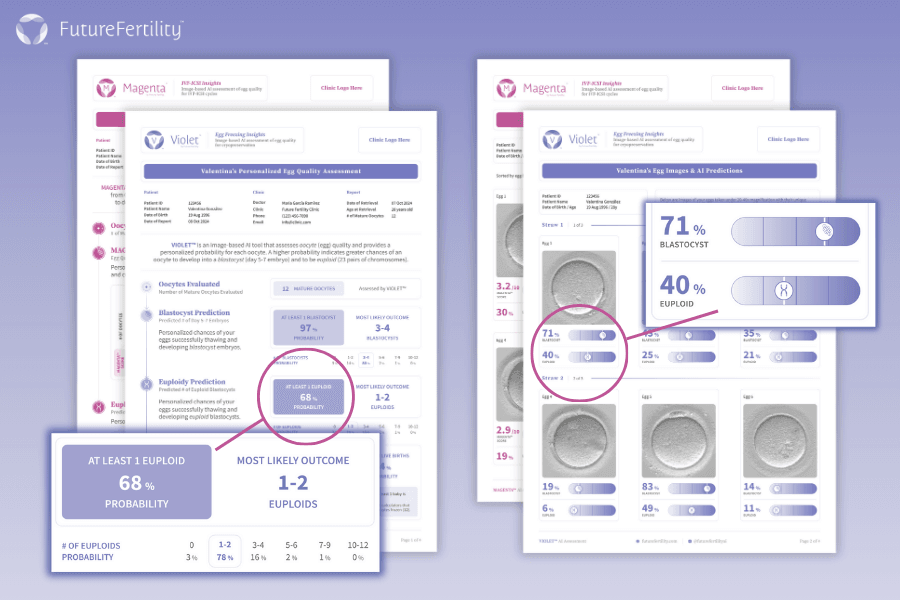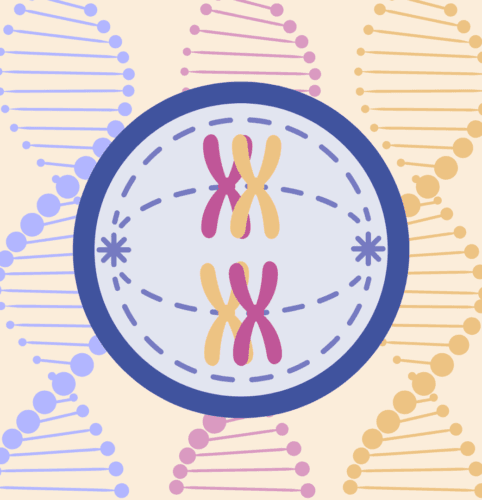If you’re going through IVF or considering egg freezing, you may have heard about “euploid embryos.” But what does that mean, and why does it matter for your fertility journey? Understanding the role that chromosomes play in embryo development can help you make informed decisions about your reproductive options.
What is a Euploid Embryo?
Chromosomes are tiny but mighty architects of DNA—thread-like structures packed with genetic instructions that shape every embryo. Think of them as little blueprints for development. Every cell in the human embryo should have 46 chromosomes, arranged in 23 pairs—half from the egg and half from the sperm. An embryo is considered euploid when it has the correct number and pairings of chromosomes, which correlates with normal embryonic development and greater likelihood of pregnancy success.

Complete set of human chromosomes, a karyotype, shown numbered and including the sex chromosomes X or Y. Each pair contains one chromosome from the egg and one from the sperm. Image credit, adapted from kanyanat wongsa/Shutterstock
Conversely, embryos with an incorrect number of chromosomes—either extra or missing copies—are called aneuploid. These abnormalities can occur naturally due to errors during meiosis—the process of cell division in egg or sperm formation—and they become more common with maturing maternal age, as older eggs are more likely to experience mistakes during chromosomal division.
Common types of aneuploidy include:
- Down syndrome (Trisomy 21): An extra copy of chromosome 21 (three chromosomes instead of the correct pairing of only two)
- Edwards syndrome (Trisomy 18): An extra copy of chromosome 18
- Turner syndrome (Monosomy X): A missing X chromosome in females

Human karyotype consistent with Down Syndrome, where chromosome 21 contains an extra copy. Image credit, adapted from kanyanat wongsa/Shutterstock
Chromosomal Abnormalities in Pregnancy
Euploid embryos are much more likely to implant successfully and lead to a healthy pregnancy than aneuploid embryos. They also carry a lower risk of loss. Studies have shown that:
Why Does Aneuploidy Increase with Maternal Age?
As eggs age, errors in chromosome division become more frequent, thus resulting in fewer euploid embryos. Research analyzing 500,000 pregnancies found that the risk of aneuploidy increases significantly with age:
- 30-34 years old: < 2x increased risk
- 35-39 years old: 4x increased risk
- 40-44 years old: 16x increased risk
- 45+ years old: 36x increased risk (source)
While younger patients, on average, have a higher probability of achieving euploid embryos, egg quality still varies by the individual. Therefore, occurrence of chromosomal abnormalities can be widely different among persons within the same age group (source).
Knowledge is power, and understanding the likelihood of euploidy in your embryos is helpful during fertility planning. Proactively discussing options with your fertility team— like egg quality assessment, future cycle planning, embryo screening, or using donor eggs —can provide you with more information to make confident decisions along your way.
Euploid Embryo Testing: How Can You Assess Euploidy?
Determining euploidy is not as simple as looking under a microscope. Traditionally, the most common way to assess is through Preimplantation Genetic Testing for Aneuploidy (PGT-A) during IVF. A small biopsy is taken from the embryo during the blastocyst stage (day 5-7) and cells are analyzed to determine chromosome count.
Although the procedure is generally considered safe, there is a small risk of embryo damage during biopsy. Additionally, not all embryo cells are tested, meaning results may not reflect the entire embryo (source). Some embryos show mosaicism, meaning they contain a mix of both euploid and aneuploid cells (source). Lastly, it is also important to recognize that while PGT-A can provide valuable information, it does not guarantee pregnancy success, as it only represents a small sample of cells, at a single point in time of embryonic development.
New Non-Invasive AI Insights for Egg Quality
PGT-A after fertilization has been the primary method available for assessing and indicating euploid likelihood of an embryo. But what if you could gain insights earlier in the process?
Future Fertility has developed an AI-powered assessment tool that analyzes images of your eggs post-retrieval (before fertilization) to predict their likelihood of developing into euploid embryos.
You might wonder, “What about the sperm?” Research has shown, however, that eggs play a dominant role in determining ploidy status (source). Therefore, insights from the egg could be an extremely valuable indicator of embryonic genetic potential.
This method is completely non-invasive, meaning no harm is done to your eggs or future embryos. Future Fertility’s Euploidy Insights are available in VIOLET™ and MAGENTA™ egg quality reports—ask your clinic about receiving an assessment.

What’s Next for Your Fertility Journey?
Understanding the reproductive potential of your eggs is a powerful tool in fertility planning. Whether you’re:
- Considering egg freezing and want to understand your egg quality
- Undergoing IVF and want to maximize your chances of success
- Seeking more clarity before your next treatment decision
…these valuable insights can help reduce the emotional stress of uncertainty and allow you to have more realistic expectations for success.
Though small, the mighty chromosomes play a big role in reproductive health. By understanding why chromosomes count, you’re one step closer to making informed and empowered fertility choices.
You Might Also Like …
Join our mailing list for dispatches on the future of fertility

